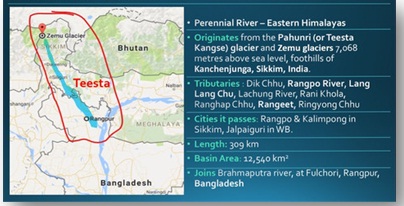
|
Syllabus: Prelims GS Paper I : Current Events of National and International Importance. Mains GS Paper II : India and its Neighborhood- Relations. |
Context
According to the latest reports, China is going to lend around $1 billion for Teesta River project to Bangladesh.
According to Bangladesh media reports, Dhaka is to receive a loan of nearly USD 1 billion from China to maintain water levels during the drought season after efforts to approve a water-sharing deal with India failed. A massive project funded by China has been adopted for the management of the Teesta River and China has agreed to fund it.
In Detail
Bangladesh Ministry sought a $983.27 million loan from China to implement a "Teesta River Comprehensive Management and Restoration Project".
The project summary states that floods lead to serious erosion for a lack of necessary protective measures, leaving huge amounts of property and home estates submerged every year.
Dhaka has been awaiting a conclusion of the Teesta water sharing agreement with New Delhi and has blamed the latter for its water woes since the former is a lower riparian state and is at the mercy of water that flows from India into Bangladesh. But the deal is pending for the last eight years due to the strong opposition of regional party to it.
 A dam constructed on the Indian side causes the water flow to reduce downstream in winter, leading to a water crisis for two months on the Bangladesh side, hence The implemening project helps, a vast area on the Bangladesh side can be supplied with water during the crisis season.
A dam constructed on the Indian side causes the water flow to reduce downstream in winter, leading to a water crisis for two months on the Bangladesh side, hence The implemening project helps, a vast area on the Bangladesh side can be supplied with water during the crisis season.
The Teesta River Dispute
The Teesta river originates in Sikkim and flows through West Bengal as well as Bangladesh. India claims a share of 55 percent of the river's water but the Bangladesh wants a higher share than it gets now. Currently, its share is lower than that of India's.
Negotiations on how to share the water have been going on since 1983. A 2011 interim deal - that was supposed to last 15 years, gave India 42.5 percent of the Teesta's waters and gave Bangladesh 37.5 percent, but the deal has been never signed.
Bangladesh wants 50 percent of the Teesta's waters between December and May every year, because that's when the water flow to the country drops drastically, which negatively affects the livelyhood of both farmers and the fisherman.
|
Teesta River is one of the 54 rivers that enter Bangladesh from upstream India before flowing into the Bay of Bengal. The Teesta River originates at TsoLamo, India, and flows through the states of Sikkim and West Bengal in India and the Rangpur division in Bangladesh before pouring into the Brahmaputra River at Chilmari, Bangladesh. |
The river is Bangladesh's fourth largest transboundary river for irrigation and fishing. The Teesta's floodplain covers 2,750sq km in Bangladesh. Of the river's catchment - an area of land where water collects - 83 percent is in India and 17 percent is in Bangladesh.
That means more than one lakh hectares of land across five districts in Bangladesh are severely affected by withdrawals of the Teesta's waters in India. These five Bangladesh districts then face acute shortages during the dry season.
India says it has its own compulsions as it does not have enough water to meet the irrigation needs also India wants to increase the area under irrigation in North Bengal to boost agricultural production to meet the target of bringing in 1.5 lakh acres of farmland.
Hydropower on the Teesta is another point of conflict. There are at least 26 projects on the river mostly in Sikkim, aimed at producing some 50,000MW.
Bangladesh China Relations
China is the biggest trading partner of Bangladesh and is the foremost source of imports. In 2019, the trade between the two countries was $18 billion and the imports from China, which was heavily in the favour of China.
Recently, China awarded Bangladesh by offering 97% of imports at zero duty. The concession flowed from China’s duty-free, quota-free programme for the Least Developed Countries. This move has been widely welcomed in Bangladesh, with the expectation that Bangladesh exports to China will increase.
Additionally, Bangladesh’s strong defence ties with China make the situation complicated. China is the biggest arms supplier to Bangladesh and it has been a legacy issue after the liberation, officers of Pakistan Army who were well-versed with Chinese arms joined Bangladesh Army and that’s how they preferred Chinese weapons As a result, Bangladesh forces are equipped with Chinese arms including tanks, missile launchers, fighter aircraft and several weapons systems. Recently, Bangladesh purchased two Ming class submarines from China.
Conclusion and Suggestions
Countering China on this front India too has provided developmental assistance worth $10 billion, making Bangladesh the largest recipient of India’s total of $30 billion aid globally.
In the last five months, India and Bangladesh have cooperated on pandemic-related moves like support in the regional emergency fund for fighting Covid-19. India has also provided medical aid to Bangladesh. India has given 10 locomotives to Bangladesh.
So far India's relations with Bangladesh have been on right track, but the effort continue to follow like complete the negotiations with mutual consensus on the ongoing Teesta River dispute.
Connecting the Article
Question for Prelims
Consider the following statements, with reference to the Teesta River.
1. It originates from Nepal Himalayas.
2. It joins Brahmaputra in Assam.
Which of the following statements is/ are correct?
(a) 1 only
(b) 2 only
(c) Both 1 and 2
(d) Neither 1 nor 2
Question for Mains
Examine India's ‘Neighborhood First’ policy in the context of India-Bangladesh relations.

Our support team will be happy to assist you!
